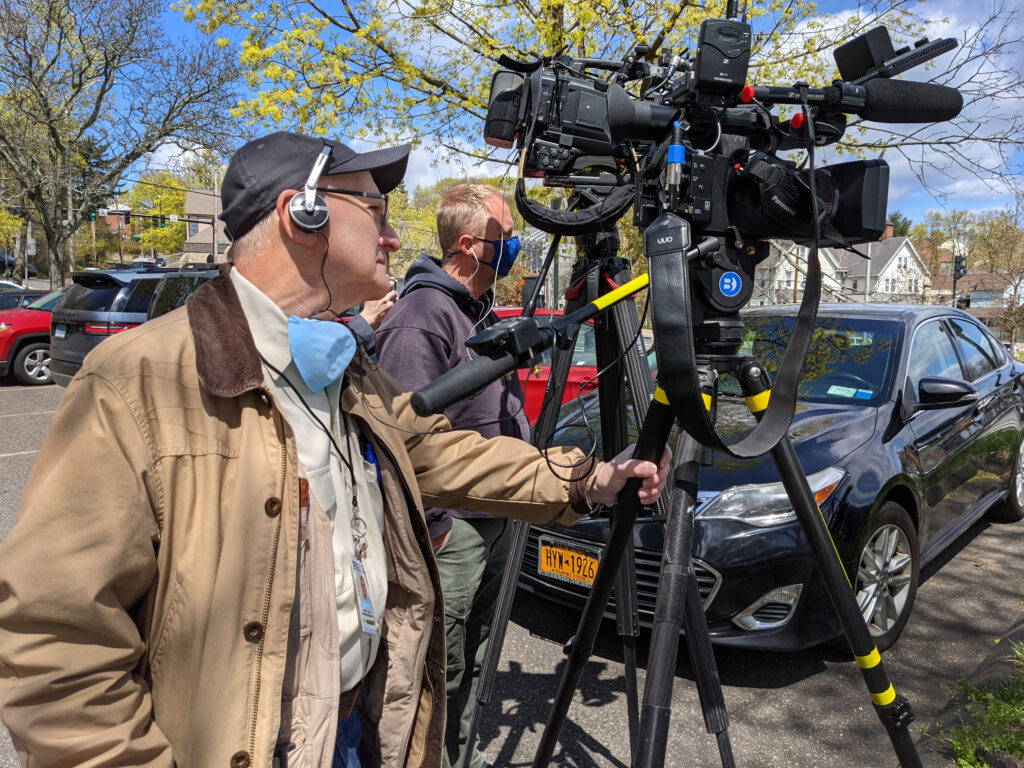Why media liability insurance is key to making sure your newsroom continues to exist
By Elise Czajkowski
For small newsrooms, media liability insurance may seem nonessential, or like a luxury — until the day it becomes wildly necessary.
In the modern era, anyone producing journalism — particularly investigative journalism — runs the risk of a lawsuit. Even if a case is eventually decided in favor of a nonprofit publisher, the legal fees can be exorbitant and sometimes crippling. News outlets are a favorite target of strategic lawsuits against public participation, also known as SLAPPs, according to the Reporters Committee for Freedom of the Press. Lawsuits filed in states without anti-SLAPP laws can drag on for years and cost millions of dollars, even when the news outlet’s reporting is solid.
Often, the purpose of defamation suits is not to seek a correction or money but to silence news organizations whose work threatens powerful people and to bully other outlets into not covering them in the future. Even the threat of a lawsuit can financially drain a small organization.
INN strongly recommends that all independent news organizations carry insurance, especially media liability insurance and directors & officers insurance. Below, we highlight four INN members’ experiences with media liability insurance, defamation lawsuits, and the need to protect nonprofit media.
In the nonprofit space, a lawsuit by the charity Planet Aid against the Center for Investigative Reporting’s “Reveal” radio show is one of the best-known defamation cases in recent years. After “Reveal” reported on Planet Aid’s financial practices around the world, the charity sued CIR for libel in 2017. Over the next five years, CIR spent millions responding to the claims. Thanks to media liability insurance coverage and pro bono attorneys, the outlet was able to defend itself — and ultimately prevail. In October, the court found that, under California’s anti-SLAPP law, Planet Aid must pay $1.9 million to cover CIR’s costs. Most of the money will go back to the insurer, with other money going to support pro bono legal efforts.
Mother Jones
For years, the nonprofit magazine Mother Jones didn’t have media liability insurance, according to CEO Monika Bauerlein. She believes that in the early years of the publication, which was founded in 1976, it embraced the theory that an organization without any meaningful resources or insurance wouldn’t be worth suing.
But Bauerlein knows firsthand that lawsuits aren’t always seeking money. In 2012, Mother Jones reported on a major donor to Republican presidential nominee Mitt Romney, mentioning reporting from the Post Register in Idaho Falls that touched on the donor’s anti-gay politics.
In 2013, after Romney’s loss — and Mother Jones’ reporting on his 47% comments — the donor sued the magazine. The defamation case centered on how Mother Jones reported on the donor’s strong efforts to cast doubt on what the magazine described as a “story revealing that local officials of the Mormon church, which sponsored local Boy Scout troops, had been aware that several pedophiles were serving as scout leaders or camp employees but did nothing about it.”
The donor sued for $74,999, the maximum allowed to keep the case in Idaho state court. That meant the California-based publication was required to defend itself in Idaho, a state without anti-SLAPP laws where the plaintiff had ample ties to the community.
Over the next three years, Bauerlein estimates that the outlet spent $3 million defending itself in the case, with at least $750k coming out of Mother Jones’ budget directly. The rest came from the company’s media liability insurer. Mother Jones prevailed on summary judgment before the case went to trial, but because Idaho does not have anti-SLAPP legislation, it recovered no money from the plaintiff after the case.
Mother Jones’ media liability insurance came with a self-insured retention, similar to a deductible, which required it to pay out of pocket initially. When the donor decided to go after the Post Register reporter in Idaho and his former partner as well, Mother Jones decided to cover the costs of their defense as well, which was not covered by its insurance policy.
For Bauerlein, the lesson is that a news outlet can be sued about any story. If full-time legal review is not an option, she says training your staff to spot potential issues requiring pre-publication review is key to protecting yourself.
But even watertight reporting is not immune.
“I think in this climate that we’re in at the moment, where litigation has become sort of a tool of people who have a bone to pick with the media generally, I would not encourage people to consider high-deductible plans on the theory that, ‘well, this isn’t going to happen to me,’” said Bauerlein. “Just like with health insurance — it’s most likely going to happen, and it’ll be pretty devastating.”
East Lansing Info
When East Lansing Info’s citizen journalists covered a local real estate developer who had been trying since 2002 to land a $100 million public-private redevelopment deal with the City of East Lansing, they were confident in their reporting. But many years into that coverage, the developer brought a libel suit against ELi and its founder, Alice Dreger, alleging defamation, invasion of privacy, injurious falsehood and “tortious interference with business relationships.”

The suit specifically named Dreger’s June 2020 writing about the developer’s federal indictment for financial crimes, including tax evasion and bank fraud. In April 2022, the developer pleaded guilty on one charge, tax evasion, and was sentenced to 38 months in federal prison. He also was ordered to pay over $1.3 million in fines and fees.
The developer attempted to have the alleged defamation case against ELi and Dreger tried in another county in Michigan; Dreger and her team assumed that he was trying to avoid a local judge who was already familiar with him.
At the first court hearing, ELi’s and Dreger’s request to change venue was granted, and the case was moved to Ingham County, where East Lansing is located. But the first judge declined to dismiss the case. During COVID-related court delays, the developer also filed various motions, including subpoenas, all of which required Dreger’s and ELi’s lawyer to respond.
The small news outlet of part-time staffers didn’t have media liability insurance, nor did it have the money to defend against this lawsuit. It was only after the suit was filed that Dreger discovered that her personal liability insurance — which she had been paying on her homeowner’s insurance for 15 years — would not cover her for this type of accusation.
Dreger estimates that she has paid about $50,000 out of pocket for the outlet’s legal defense so far, and will likely pay more. The plaintiff is now appealing the case at the Michigan Court of Appeals, and may continue on to the Michigan Supreme Court.
Use this resource: Want to learn more about media liability insurance and resources available to your newsroom? Click here. INN also offers a how-to guide, Buying Media Insurance, for its members; please email info@inn.org to get a copy. See here to watch a free webinar about media liability insurance from INN and Media Risk Consultants. Email services@inn.org with additional questions or to set up a consultation with staff.
Now, Dreger says she is hoping to acquire media liability insurance for the outlet, although she assumes she will have to wait for a time after the lawsuit. A few local supporters of ELi had offered to help with a legal defense fund, but Dreger asked that they donate to the newspaper instead.
“It’s very easy to crush a place with even just an initial lawsuit,” said Dreger. “A lot of places can’t afford to keep their doors open even with just the first blow from a lawsuit.”
Nancy on Norwalk
In 2017, when Claire Schoen joined the all-volunteer board of directors at Nancy on Norwalk, a small news publication based in Norwalk, Connecticut, one of her first priorities was getting directors and officers insurance for the outlet.
At the time, the startup news outlet, co-founded by Nancy Chapman, didn’t think that media liability insurance was affordable or possibly even needed. Schoen had begun looking into insurance when, in 2018, Chapman was personally sued by a former state Senate candidate for writing about his previous DUI arrest. The candidate’s charges were dismissed after he completed an accelerated rehabilitation program.

The outlet sought out help from the Media Freedom & Information Access Clinic at Yale Law School, which provided pro bono support. Ultimately, the politician withdrew the claim before a judge could rule on the motion.
Schoen said she assumed the threat of the lawsuit would make it impossible to get media liability insurance, but she was pleased to discover a local broker who would insure the outlet. She says the publication, which has only one full-time staffer and an annual budget of less than $100,000 per year, spends approximately $2,000 per year on its policy.
“It’s just really important to have it — I think as much for peace of mind for the organization as just general protection,” said Schoen. “We’re doing this out of a love for news.”
Center for Public Integrity
The Center for Public Integrity is no stranger to litigation. In one of the biggest libel trials of recent times, the billionaire owners of a Russian bank sued the investigative reporting organization for its coverage of their relationship to then-vice presidential nominee Dick Cheney. Five years and millions of dollars later, the case against CPI was finally dismissed.
These days, the outlet has shifted its focus almost entirely to domestic issues. But the company is still careful to make sure it is protected from any legal action, says CPI Chief of Staff Jin Ding.
For CPI, an insurance policy that protects it at every level — from subpoenas to full-blown lawsuits — is vital to its newsroom. (In fact, the employee handbook specifically states that the outlet will fight subpoenas that are issued for its staff.) Ding says it’s also important that the policy covers any freelancers or contractor writers that they work with.
“For us to continue investing money into media liability is basically making sure that we can still exist. Making sure that if there’s anything wrong that we can have that resource to protect ourselves.”
Jin Ding, Chief of staff, center for public integrity
Like many journalists who find themselves thrust into the business side of the media industry, Ding didn’t have a background in organizational operation. They said they’ve learned on the go by asking colleagues and consulting with the outlet’s insurance broker about questions. Luckily, they said, CPI hasn’t had to use its insurance policy in the past few years.
When legal concerns arise, CPI has an attorney on retainer who provides pre-publication review of investigations. Its insurance policy also allows for pro bono legal advice as needed. For its comprehensive policy, the center pays about $45,000 per year.
“For us to continue investing money into media liability is basically making sure that we can still exist,” said Ding. “Making sure that if there’s anything wrong that we can have that resource to protect ourselves.”
Use this resource: Are you an INN member interested in media liability insurance? Contact Rina Hamzey at Endless Insurance Services and ask about the INN preferred program.
Ask an insurance broker
Media liability insurance isn’t always straightforward — if anything, its complexity can be intimidating. So we asked Rina Hamzey of Endless Insurance Services, INN’s preferred broker, to answer a few common questions about media liability insurance. (These answers have been edited for clarity.)
How are rates for media liability insurance set?
Rates are set based on the revenue of the organization, the content of the site and the state that the outlet is in.
For instance, an organization that’s focused on investigative news is going to have a higher premium than one covering something less controversial. Some insurance companies won’t even offer quotes to investigative news outlets, as they feel the risks are too high.
Most media liability insurance policies offer $1 million in coverage. But the retention rate that an outlet pays will be individually assessed.
What is the difference between a retention and a deductible?
They’re essentially the same thing. The retention is the portion of a bill that the client is responsible for in the event of a claim. And the outlet is responsible for paying that portion for each claim, as opposed to an annual deductible.
Is it standard for media liability policies to cover freelancers?
Most of the policies already include it, because they know that the freelancers are writing on behalf of the organization. A policy will generally cover “any agent or independent contractor, but only while providing content to or on behalf of the named insured.” Each policy is going to have its own verbiage. But more often than not, it’ll say it’s extended to the independent contractors.
Can a news outlet use pro bono attorneys if it has a media liability policy?
It’s not unusual for news organizations to have a pro bono attorney review content before it gets published.
But once a claim occurs, the outlet has to put the claim in with the insurance company. The insurance company is the first party that should be involved in the claim. The adjuster who gets assigned to the claim is the best person to then advise on finding a legal team.
If a news organization already has counsel, it can ask the insurance company to pre-approve that attorney when purchasing a policy. This means that if a claim is filed, the outlet can immediately begin working with its lawyers.
If a news outlet has already been sued, will that make it harder to get media liability insurance? What can they do?
Yes. And a lawsuit can cause an insurance company to cancel an existing policy or increase the policy’s rate.
When considering a policy for an organization that has been sued, an underwriter will ask about the changes in procedures that the outlet has undertaken to avoid the same situation from happening again. They want to see that the organization is taking steps to avoid being the subject of this type of claim again.
Do you have any advice for news outlets considering purchasing media liability insurance?
Applications for media liability insurance are long and nuanced. But the questions that the policy application asks are a good guideline. Make sure you’ve implemented that stuff, like making sure you have contracts with your independent contractors.
To me, media coverage for an organization is like malpractice insurance for a doctor. It’s super important.
This study was made possible thanks to generous support from Democracy Fund, as well as our general operating funders.
